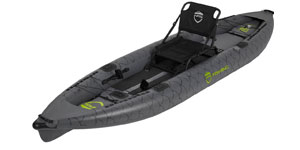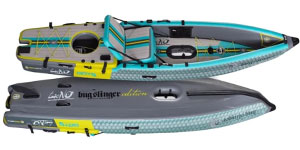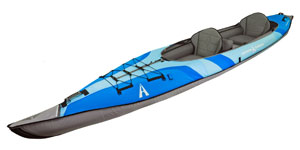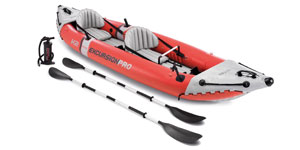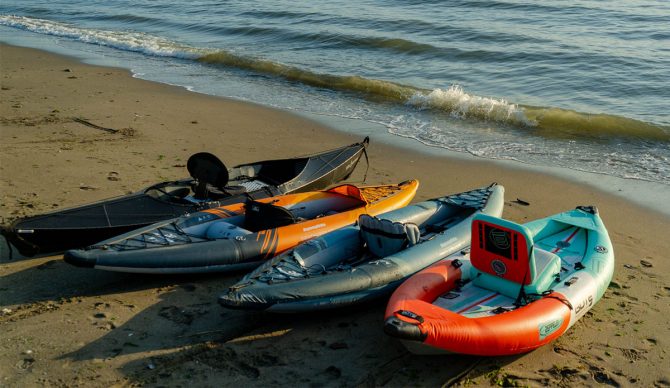
Inflatable kayaks bring the versatility of a true watercraft without the need to transport a heavy fiberglass shell. Photo: Steve Andrews//The Inertia
Owning a watercraft opens up a whole new world of adventure. But most of us don’t have the capacity to take on a rigid and full-sized boat, which is costly, cumbersome, and not exactly mobile when not in the water. Enter the inflatable kayak, which packs down small for easy transport and storage. And with recent innovations in materials and design, not only do today’s inflatable kayaks get you around on the water with efficiency, but they are also built to last and are fully capable of withstanding the rigors of outdoor adventures.
We put over a dozen models through two rounds of testing at choice locations in Vancouver, Canada, and the Outer Banks in the U.S. On both pristine days and in hairy conditions, in lakes, sounds, and out on the open ocean we put these kayaks through their paces to test their performance, ease of use, and how they fare in a variety of circumstances. The result is the list you see here.
Navigate To: Comparison Table | Rating Chart | Buyer’s Guide
Related: Best Inflatable Paddle Boards | Best Life Jackets | More Gear Reviews
The Best Inflatable Kayaks of 2025
Best All-Around Inflatable Kayak: NRS Pike
Best Lightweight Inflatable Kayak: Aquaglide Cirrus Ultralite 110
Most Innovative Inflatable Kayak: BOTE LONO Aero
Best Tandem Inflatable Kayak: Advanced Elements AdvancedFrame Convertible Elite
Best Value Inflatable Kayak: BOTE Zeppelin Aero
Best Budget Inflatable Kayak: Intex Excursion Pro K2
Best All-Around Inflatable Kayak
NRS Pike ($995)
Versions: 12.6, 12.6 Pro
Length: 12’ 8”
Weight: 48 lbs
Weight Capacity: 375 lbs
Packed Dimensions: 36 x 22 x 14 inches [roller bag], 24 x 19 x 7 inches [detachable chair, folded]
Storage Space: Bungees in front and back, small floor space in back, 20 D-rings
Pros: Super stable, excellent seat, high-quality carry-backpack, overall feeling of security on the water, optimal for fishing
Cons: On the heavy side, no setup instructions
The NRS Pike 12.6 impresses right out of the box, packed neatly in its sleek travel bag, which is equipped with padded, reinforced backpack straps for ease of carry. The setup process was prolonged by the lack of a clear setup guide (in fact, ours came with the wrong owner’s manual). This added to the initial setup time, but once you get the hang of it, this kayak is not difficult to assemble.
The construction of this kayak is one of the best we tested with high-quality materials (a sturdy 1,000-Denier PVC with a super solid deck, padded and protected with EVA foam) and design (the slight rocker bow to stern is punctuated by a rigid keel in the bow for improved tracking). The 4” drop-stitch deck inflates to an impressive 8 PSI, and while the BOTE models we tested offer more rigidity, this amount of pressure made it relatively easy to pump up, while still giving the user plenty of security and stability on the water. In fact, this was one of the few models we tested that we felt comfortable standing up on, which makes it even more convenient for fishing, as you can stand up to cast and reel. Speaking of fishing convenience, the 24” fish measuring board lets you know this kayak means business when it comes to fishing. Along the edges of the fishing board are traction pads for sure footing, and attached to the inner side walls are foot-rest inserts for extra comfort and stability while paddling.
Perhaps the best part of this kayak is the seat: mesh with an aluminum frame that is elevated such that the rider sits even with the top of the 10.5” side tubes. The height improves visibility while maintaining stability, but it is the comfort of the seat we’d really like to dote on. A lot of inflatable kayaks have inflatable seat cushions, and while the seats that can withstand higher air pressure and have backrests offer decent comfort, comparatively, the NRS Pike seat felt like pure luxury.
The Pike has plenty of space for extra items, whether you are fishing or enjoying a leisurely day on the water, and there are bungee cords front and back along with daisy chains for additional storage. The grayscale exterior with green lettering is sharp while maintaining a low profile, but any experienced kayaker will notice the top-notch quality of this vessel at first glance.
Riders will feel secure, comfortable, and ready for anything a day on the water can throw at you with the NRS Pike. With its thoughtful touches, advanced durability (it comes with an impressive 3-year warranty), and mid-range price point, this inflatable kayak captured and kept our attention throughout the testing process, ultimately earning the award for Best Overall.
Check Price on theyakshakBest Lightweight Inflatable Kayak
Aquaglide Cirrus Ultralight 110 ($1,299)
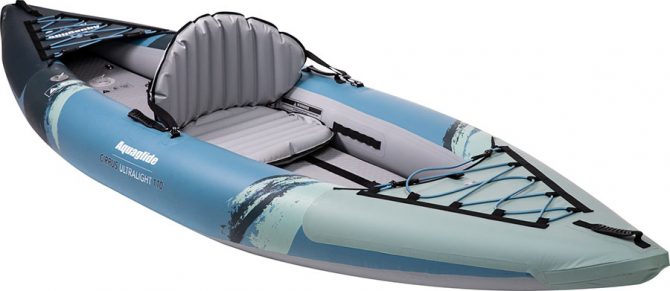
Versions: 11′ (solo), 15′ (tandem)
Length: 11′
Weight: 14 lbs 12 oz
Weight Capacity: 300 lbs
Packed Dimensions: 23 x 15 x 16 inches
Storage Space: Front and back deck bungees
Pros: Low profile, easy setup, moves fairly well on the water
Cons: Pricey, thin walls had us scared of rocks
The Aquaglide Cirrus Ultralight 110 takes the idea of a packraft (a lightweight inflatable boat that can be packed up small and carried for long distances) and gives it a few upgrades to bring things more in line, performance-wise, with what one might expect from a traditional inflatable kayak. At 14.75 lbs, it certainly isn’t as light as a true packraft (which often clock in at under 10 lbs) but the performance improvements are certainly worth the extra weight, depending on how far you plan on carrying this thing.
In addition to being fairly lightweight, the Aquaglide Cirrus Ultralight kayak packs up so small in the included carrybag/drybag you could include it in a bigger pack to take to some pretty incredible places off the beaten path. Whether it’s a majestic alpine lake or a remote beach, this kayak is very transportable.
When unpacked, it sets up easily and effortlessly and holds up well out on the water. A removable fin at the stern and “flexible bow extrusion” help improve this kayaks tracking on the water, a step-up over more traditional “packraft-style” watercrafts we tested, though not quite as good as some of the heftier inflatable kayaks we tested. The ultralight design, while certainly sturdy-feeling is also not as durable as, for example, the 1,000-Denier PVC walls of the NRS Pike, above. The biggest downside of this kayak is the price, which is fairly steep for such a simple kayak, but understandable given the lightweight construction and materials. For a similarly lightweight-but-fully-featured inflatable kayak that is more budget-friendly, the Aquaglide Deschutes 110 ($550), below, weighs 19 lbs but doesn’t pack down as small. For a true ultra-lightweight packraft, the Kokopelli Hornet-Lite ($599) clocks in at a mind-boggling 5.2 lbs, but sacrifices a fair amount on features and performance.
Check Price on UMIAK Check Price on REI
Most Innovative/Most Versatile Kayak
BOTE LONO Aero ($1,549)
Length: 12’6″
Weight: 51 lbs
Weight Capacity: 400 lbs
Packed Dimensions: 41 × 19 × 13 inches
Storage Space: High walls and long hull make for ample free storage space, bungee straps on nose and rear, velcro removable stash pockets, port for cooler (sold separately)
Pros: Super versatile (converts to SUP and can install a foot-pedal system with rudder), exceedingly sturdy design, very rigid, tons of accessories and extras like the MAGNEPOD for a magnetized tumbler
Cons: Heavy, lengthy setup (total of 6 chambers to pump up, but electric pump helps), costly
There’s no way around it: the BOTE LONO Aero stands alone when it comes to innovation and versatility. At just over $1,300 it’s not cheap, but it is immediately evident that you are getting what you pay for. This is especially true if you are in the market for both a kayak and a stand-up paddle board, as the LONO Aero easily converts back and forth to either. Simply remove the seat and back cover, which is effortless thanks to the elegantly designed G-clip fastening system, and what was once a top-of-the-line inflatable kayak is now a more than capable SUP.
The side walls are extremely rigid (inflating to an astounding 10-15 PSI) and high, which gives the rider some extra protection from rougher waters, but does leave it more vulnerable to wind sway. The floor is a built-in chamber that also inflates to 10-15 PSI, making it exceedingly stable as a kayak, though we did experience a bit of a wobble on windy days when using it as a SUP, perhaps due to the high walls. All-in-all, the superior AeroBOTE technology allows for high rigidity, enhancing its ability to track and remain stable in tough conditions and justifying the Lono’s namesake as the Hawaiian god of tenacity and vigor.
Though we did not get a chance to check out the pedal system, this kayak also boasts the ability to go hands-free with the (sold separately, $899) APEX Pedal Drive and rudder steering attachment. As an excellent kayak with the option for pedals or converting to a SUP, you are probably beginning to see why this kayak takes the cake for the most innovative and versatile.
The LONO also impresses with a ton of accessories and little details. For one, the owner’s manual was by far the most succinct and helpful, with plastic, color placards on a mini carabiner, making it easy for review and transport. The kayak also comes equipped with bungee cords on the bow and stern for extra storage, detachable mesh side pouches, and plenty of extra space in general. The luxuries keep coming with a MAGNEPOD 20 oz. tumbler that attaches securely to the magnetic holder in front of the seat. This extra touch of convenience accentuates this already highly convenient convertible model. Paddle straps and high-grade grab handles grace the tops of both of the side walls, and there is another grab handle in the bow making it easier to pull in and out of the water.
The seat is also remarkable, a true plus in the world of inflatable kayaks. The seat inflates to an impressive 7-10 PSI, offering both comfort and support, and with the double cushion, riders sit high on the keel with the side walls.
The LONO Aero is not perfect in every way, but for every challenge, BOTE is thoughtful in approaching the solution. When the pedal system is not installed, there is a clear plastic insert that gives you a window into the underwater world below while you ride. Installation, in general, was straightforward but somewhat time-consuming with its three big chambers (six if you include the removable top and seat cushions), but BOTE offers an excellent high-pressure AeroPump Auto Electric Pump II ($170) that speeds up the process and attaches to car plugs and batteries. Moreover, though the robust package brings the loaded bag weight to 73 lbs, it comes with a well-made, suitcase-style travel bag with padded handles, an extra front pocket, and wheels for easy travel. Read our full review of the Lono Aero here.
Check Price on AmazonBest Tandem Kayak
AdvancedFrame Convertible Elite ($1,200)
Versions: 15’
Length: 15′
Weight: 52 lbs
Weight Capacity: 550 lbs
Packed Dimensions: 36 × 21 × 11 inches
Storage Space: Front bungee straps, limited storage unless using as a single paddler
Pros: Straightforward design, relatively easy to set up, great performer on the water, high-quality, durable material, tracks well
Cons: Any storage needs to be minimal, attaching pump to the floor chamber is a tight squeeze, not much body space
The AdvancedFrame Convertible Elite is elite indeed when it comes to tandem kayaks. Heads up, at 52 lbs, it was a little difficult to carry, and though the travel bag comes equipped with backpack straps, it was not as comfortable to carry as some other models. But seeing how it is a tandem unit, a duo could take turns carrying this kayak on a light hike, though we would advise that you avoid strenuous uphill climbs.
Once you get to the water, the Convertible Elite really begins to shine. During a surprisingly simple, quick setup for such a big vessel, we really began to notice the quality design, with aluminum rib-frame technology in the front and back, reinforced seams, and a durable drop-stitch floor. The design feels super secure – we tested it out as a family, and despite the added weight and movement of a one-year-old, the kayak performed. Durability is another area that this kayak shines. Amidst a quickly dropping tide during testing, we briefly found ourselves on a bed of oyster shells – a less-than-ideal scenario for an inflatable kayak – but due to the welded seams and three-layer material used in this kayak’s construction, we came out of the encounter without a scratch.
This model was not overly spacious for a tandem, but the bungee cords in the front do offer extra storage. Also, it converts easily to a single paddler, and in this setup you have ample storage room. With its long, slender design and skeg/tracking fin, it tracks quite well and we worked up a decent speed, even against the wind, though this design also made it somewhat difficult to maneuver quickly.
The seats have high backs with lumbar support and riders sit down in the unit like a more traditional kayak. This put you right near the surface of the water, but did not make for an especially comfortable ride. Other features include D-ring tie-downs, molded rubber carry handles, and paddle holders. In sum, the AdvancedFrame Convertible Elite is an excellent touring-style kayak, more than worthy of our Best Tandem ranking.
Check Price on REI Check Price on Amazon
Best Value Inflatable Kayak
BOTE Zeppelin Aero ($699)
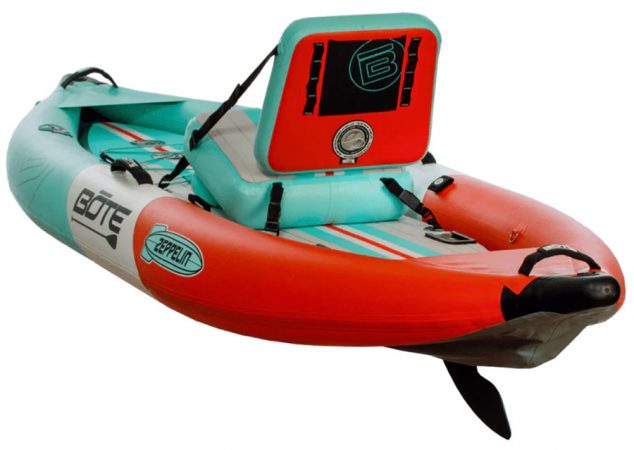
Versions: 10′, 12’6″ (Tandem)
Length: 10′
Weight: 46 lbs
Weight Capacity: 300 lbs
Packed Dimensions: 39 × 18 × 11 inches
Storage Space: Front webbing, back deck with optional attachments
Pros: Low profile, easy setup, moves well on the water, super stable and maneuverable thanks to pontoon sidewalls and tri-fin system, can be used as SUP, durable
Cons: Heavy in comparison to others we tested
If you’re the type who enjoys their time on the water more than wherever they are headed, then the BOTE Zeppelin Aero might be the best inflatable kayak for you. While it still gets around with ease, where it really stands out in how solid of a build it is. With their thick-walled, proprietary AeroBOTE construction, this kayak feels like it will last for years. Pumping it up was easy enough with three main chambers and an inflatable seat all topped up in under 10 minutes.
Out on the water this boat was very stable, even in rough wind chop. And even though water was splashing over, we stayed high and dry thanks to the elevated seat and the kayak’s ability to self-bail water through the stern (as long as you are moving). The unit is great – the only downside is that because it’s so sturdy, it isn’t the lightest, with a loaded bag weight of 46 lbs. The inconvenience of the somewhat high weight is mitigated by the well-made travel bag with padded handles and backpack straps over breathable mesh. Out of the bag, the weight drops to around 37.5 lbs, and at 10’ long with grab handles on the bow, stern, and both sides, the Zeppelin was actually quite manageable to move in and out of the water.
We are particularly fond of the pontoon side chambers, which, along with the wide base, make this kayak one of the most stable units we tested. The stability lends a feeling of security out on the open water, even in high wind and against a strong current. That feeling of security is augmented by the super sturdy floor, which inflates to 10-15 PSI, and the tri-fin design, which enhances its tracking and steering capabilities.
In fact, the design is so sturdy and stable (and the seat so easy to attach and remove, thanks to the G-clip fastening system), that we were inspired to test the Zeppelin as a SUP. Though its bigger sister, the LONO Aero (and not the Zeppelin), is marketed as a SUP/kayak convertible, we actually found that the Zeppelin performed just as well as a SUP. The floor is pretty grippy and you can easily attach a trackpad for extra traction. At the mid-level price of $699, this versatility and the overall experience it offers were major factors in deciding to choose the Zeppelin as the Best Value Kayak.
The Zeppelin is also highly durable, being constructed with AeroBOTE technology. We got into a little scrape with some dock barnacles on the way in, and the outside chamber was no worse for the wear.
As icing on the cake, the Zeppelin Aero is loaded with extra features such as a paddle strap for easy carrying/storage, tie-down loops, and removable inserts for BOTE’s Rac system that allows you to easily customize the unit with a bucket, extra storage, and more. Like the LONO Aero, BOTE included the MAGNEPOD for conveniently attaching a tumbler while you’re on the go and an intuitive owner’s manual for easy setup and review. It also comes with a super comfy seat, bungees in the front for extra storage, and a Go-Pro mount. It’s also available as a tandem kayak for two paddlers. Read our full review of the BOTE Zeppelin Aero here.
Best Budget Kayak
Intex Excursion Pro K2 ($398)
Versions: K1, K2
Length: 12′ 6”
Weight: 47 lbs
Weight Capacity: 400 lbs
Packed Dimensions: 26 × 19 × 19 inches
Storage Space: Storage space in stern and bow with D-rings for tying down other items
Pros: Long frame and removable skeg allow for decent tracking and maneuverability, tons of extras, like holder mount (for phone or camera), rod holders, and foot rests
Cons: Lower-quality material and durability, not a standout in stability, seat is not as comfortable as others we tested
The Excursion Pro K2 from Intex surprised us with how much it offers at such a low price point. If you are a beginner or just looking for an affordable means to hit the water with an inflatable kayak, then you will want to consider the Excursion Pro K2.
The quality is not going to knock your socks off, especially when you pit it against some of the more expensive models included in this review. Nonetheless, the 30ga vinyl with 3-ply construction is sturdy and durable enough to support two paddlers comfortably with peace of mind that it will not be easily damaged.
The Excursion Pro K2 also fluidly converts to a single-paddler kayak, making for a spacious, even stabler riding experience. Whether in tandem or single mode, the performance is solid, despite the fact that it cannot be inflated to a higher PSI (which increases rigidity and, in turn, usually enhances performance) relative to some of the higher-end inflatables. Less rigidity is offset to some extent by the removable skegs, which give the kayak decent tracking and maneuverability.
Yet, the Excursion Pro K2 compensates for what it lacks in on-water performance with a ton of convenient features, including floor-mounted footrests, recessed fishing rod holders on the side walls, and an adjustable holder (for phone, camera, or other accessories).
The inflatable seats are not the most comfortable we tested, but they do come with an inflatable booster cushion for elevated seating. As mentioned, space is ample, especially in single paddler mode, offering extra room for storage in the bow and stern along with stainless steel D-rings to tie down additional gear.
This model also comes with a pair of aluminum oars, an air pump, and a satisfactory carry bag. With so many features and capable of hosting a duo, we are amazed that Intex is able to offer the Excursion Pro K2 at such a reasonable price point, which is why we are giving it our Best Budget Kayak designation.
It is worth noting that we also tested the Excursion Pro K1 model, which is exclusively for single paddlers. At $211, this model is still going to get you on the water with a good amount of features at a very low price, but the smaller size and lack of rigidity really make a difference in terms of overall stability. And though it weighs about 10 lbs less than the K2, we think the K2 is worth the extra weight and increased cost due to its extra stability, decent performance, and versatility as a tandem or single-paddler kayak.
Check Price on AmazonBest of the Rest
These inflatable kayaks below may not have captured a “best of” ranking, but they are top-tier watercraft that impressed us in a variety of ways. Depending on your needs, you may find the options offered below particularly useful.
Runner-Up Best All-Around Inflatable Kayak
Aquaglide Deschutes 110 ($550)
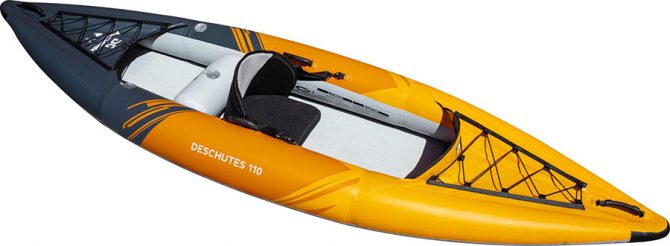
Versions: 11′ (solo), 14’6″ (Tandem)
Length: 11 Feet
Weight: 19 lbs
Weight Capacity: 300 lbs
Packed Dimensions: 30 x 18 x 15 inches
Storage Space: Bungees in front and back, D- D-rings for tie-downs, small floor space in back
Pros: Low profile, easy setup, moves well on the water
Cons: Not the most efficient while paddling
The greatest difference between a kayak and a SUP is the ability to be closer to the water, and the Aquaglide Deschutes puts you right next to the surface. This kayak was a breeze to set up. The main chambers inflate in just a couple of minutes, and the attached seat connects with just a couple of buckles.
On the water, the kayak paddles fairly well – we could easily move around, and though the tracking isn’t quite as good as other kayaks we tested, a large removable fin mounted in the stern does help maintain a forward direction while paddling. Once you get a bit of a glide going, the boat cruises with ease, though there are definitely more efficient inflatable kayaks out there.
This is a boat that checks all the boxes for summertime fun. It’s by no means a high-performance boat, but it still moves well on the water and will get you from point A to point B with ease. With a reasonable price, it’s hard to find many faults with this kayak. It was certainly enough for us to give it the title of Runner-Up Best All-Around Inflatable Kayak.
Check Price on REI Check Price on Amazon
Best Folding Kayak
Oru Kayak Beach LT Sport ($1,500)
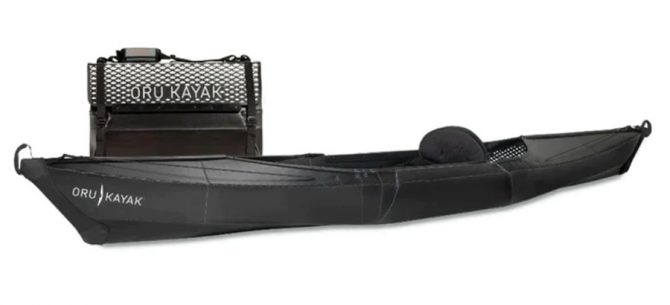
Versions: Beach LT ($1200), Beach LT Sport
Length: 12’1″
Weight: 28 lbs
Weight Capacity: 300 lbs
Packed Dimensions: 33″x 13″x 29″
Storage Space: 140 L
Pros: No pump needed, shaped hull, moves well on the water, take down is fast and simple
Cons: Square packed shape is awkward to carry with just one shoulder strap
While this kayak isn’t inflatable, we felt it’s worth mentioning because it’s pretty awesome. Using the ancient principles of Origami, Oru’s Beach LT Sport feels the most “kayak-like” of all the models we tested. Its shape and feel is similar to a hardshell kayak, yet it weighs less than 30 lbs and folds up to move and store with incredible ease. The kayak is simply designed with only a few parts separate from the main body: The oh-so-comfy seat, the rear bulkhead, and zipper units for the front and back. Everything else is a part of the single folding unit.
The initial setup admittedly took a bit longer than expected as we initially struggled to make sense of the design, but once we had things figured out, it’s remarkably easy to turn from a box into a kayak in just a few minutes. Taking it apart, or rather folding it up, is even easier and the whole process gets lots of commentary from passers-by who think it’s either genius or crazy. We can assure you that it’s more on the genius side – once paddling, the remarkable engineering really shows what it’s made of with ease of paddling and track-ability similar to a traditional hardshell kayak.
The biggest pain point of the Oru kayak was that, unlike inflatable models, the large 33″ wide box shape felt a bit awkward to carry — especially with only a single shoulder strap. So if you have to do a big trek to get to the water it might seem frustrating. But, if you want something that looks and performs great, this is a fantastic option and will last for years if you treat it well. Check out our review of the Oru Kayak Beach LT Sport here.
Super-Lightweight Packraft
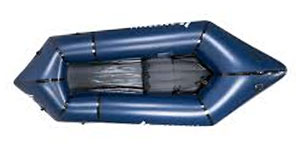
Kokopelli Hornet-Lite ($599)
Length: 7’ 1″
Weight: 5.2 lbs
Weight Capacity: 300 lbs
Packed Dimensions: 12″ x 7″ x 3″
Storage Space: Limited to whatever you can fit between your legs or stuff into the stern of the boat
Pros: Ultralight and compact, optimal as packraft, easy to set up and disassemble, minimalist design
Cons: No backrest, no skeg or fins, very little trackability, highly susceptible to the elements and fit for calm waters only, low rigidity
When stacked against other inflatable kayak models, the Hornet-Lite can be a little underwhelming at first. But when you consider that the boat weighs a mind-bogglingly low 4.7 lbs (whereas others get into the 50-lb. range) and a total of 5.2 lbs with all its key accessories, you begin to understand the allure of this model.
While other companies attempt to seduce you with a plethora of features and add-ons, Kokopelli takes a refreshingly minimalist approach with this packraft aimed at long-distance hikers as well as the fast-and-light crowd. The no-frills aesthetic (a simple, dark blue pontoon style body with black floor and seams) and easy assembly (5 minutes or less, easily inflated with hand or electric pump) make this an attractive option for those seeking a straightforward packraft to take with them on trips to calm-water destinations.
Just don’t expect the Hornet-Lite to be the most high-performing watercraft on this list. The pontoon-style walls make it plenty buoyant, but the floor is simply material (no inflatable padding, like some other models) and there are no fins, so, coupled with its low weight, the ride is heavily influenced by the wind and current. You can easily maneuver it to turn in your desired direction, but without fins and with such low rigidity, tracking is at a minimum.
It comes with an inflation bag and tube, further minimizing the accessories necessary and making it an excellent packraft. The inflation-bag method is not the quickest, but once you get the hang of it, inflating the Hornet-Lite is actually quite quick.
The inflatable seat fits the mold of the rest of the boat, both literally and in that it is minimalistic, and while it does the job, there is no back to it (though you can sort of lean against the back wall) and it does not make for particularly comfortable seating.
Then again, if you are purchasing the Hornet-Lite, you are probably not doing so for a long-range tour — it is as a no-nonsense, lightweight packraft for calm conditions that this model excels. At $550, this model is solid, if a bit overpriced, but again, with a packraft, less is more.
In case you want to kayak with company, a lot of the same things we noticed about the Hornet-Lite can also be said for its tandem counterpart, the Kokopelli Twain. The Twain is suitable as a packraft, and perfect for paddling with a partner. At 13.6 lbs and packing down to the size of a sleeping bag, you will have no problem carrying this inflatable kayak with you on the trail. Also, like the Hornet-Lite, it is easy to assemble with the included inflation bag, though it does have two chambers compared to the single chamber on the Hornet-Lite.
Unlike the Hornet-Lite, the Twain comes with easy-to-install EVA backbands for superior comfort while sitting for long stretches. The Twain model also includes a 9-inch removable fin, so although this model is prone to being knocked off course by the elements, the fin does offer a bit better tracking.
Check Hornet-Lite Price on Kokopelli Check Twain Price on Backcountry
Capable Cruiser
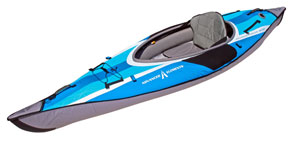
AdvancedFrame Sport ($570)
Versions: 10’ 5”
Length: 10′ 5”
Weight: 26 lbs
Weight Capacity: 250 lbs
Packed Dimensions: 30 × 17 × 8 inches
Storage Space: Front bungee straps, D-rings, small stow space behind seat, limited space otherwise
Pros: Straightforward setup, high-back seat, stable design, performs well on the water
Cons: Not much storage space, low weight capacity, tight quarters
The AdvancedFrame Sport is a fun and capable cruiser for recreational kayakers seeking the convenience of an inflatable kayak without sacrificing too much performance. Like the AdvancedFrame Convertible Elite (our vote for the Best Tandem Kayak), the Sport boasts the company’s aluminum rib-frame technology, which adds integrity to the bow and stern. With four layers of material, the Sport offers extreme puncture resistance. We can attest to this first-hand, as we encountered some oyster shells, which are notoriously sharp, and bumped some barnacles, and yet the Sport showed no signs of wear afterward.
The Sport is also a mere 26 lbs, making it half the weight of the Convertible Elite and a legitimate candidate to carry with you on shorter excursions. Though it does not come close to the compactness of the Hornet-Lite (which clocks in at 4.7 lbs), the Sport is still surprisingly light for its durable design, extra features, and high-performing frame. It packs neatly with the seat and pump into the included duffel bag. There are no pads on the straps, but technically you could put them around your shoulders like a backpack.
The relatively lightweight design of the Sport makes it easy to pick up speed and the fin adds solid tracking. The lightness means you will get pushed around a bit by wind and waves, but overall it performed well in moderate winds and against the tide.
Space onboard is a little tight, but there is bungee deck lacing, D-ring attachments, and a bit of room behind the seat to stow extra gear. The seat is solid and decently comfortable, with a high-back cushion that makes it easier to endure longer trips. If you are looking for a high-performance cruiser at a moderate price point, especially if having ample space is not a priority, then you will certainly want to consider the AdvancedFrame Sport.
Check Price on REI Check Price on Amazon
Best Inflatable Kayaks Comparison Table
| Model | Price | Length | Weight | Capacity | Packed Dimensions (in) | Storage |
| NRS Pike 12.6 | $995 | 12’ 8” | 48 lbs | 375 lbs | 36 x 22 x 14 | Bungees in front and back, small floor space in back, 20 D-rings |
| Aquaglide Cirrus Ultralight 110 | $1,300 | 11′ | 14.75 lbs | 300 lbs | 23 x 15 x 16 | Fore and aft bungees |
| BOTE LONO Aero | $1,549 | 12’ 6” | 51 lbs | 400 lbs | 41 x 19 x 13 | High walls and long hull make for ample free storage space, bungee straps on nose and rear, velcro removable stash pockets, port for cooler (sold separately) |
| AdvancedFrame Convertible Elite | $1,200 | 15’ | 52 lbs | 550 lbs | 36 x 21 x 11 | Front bungee straps, limited storage unless using as single paddler |
| BOTE Zeppelin Aero 10 | $690 | 10′ | 46 lbs | 300 lbs | 39 x 18 x 11 | Front webbing + attachments |
| Intex Excursion Pro K2 | $398 | 12’ 6” | 47 lbs | 400 lbs | 26 x 19 x 19 | Storage space in stern and bow with D-rings for tying down other items |
| Intex Excursion Pro K1 | $300 | 10’ | 37 lbs | 220 lbs | 23 x 20 x 12.6 | Storage space in stern and bow with D-rings for tying down other items |
| Aquaglide Deschutes 110 | $550 | 11′ | 19 lbs | 300 lbs | 30 x 18 x 15 | Bungees, D-rings, rear storage space |
| Oru Kayak Beach LT Sport | $1,500 | 12’1″ | 28 lbs | 300 lbs | 33 x 13 x 29 | Fore and aft bulkheads |
| Kokopelli Hornet-lite | $599 | 7’ 1” | 5.2 lbs | 300 | 12 x 7 x 3 | Whatever you can fit in hull |
| Kokopelli Twain | $1,299 | 11’ 1.25” | 14.5 lbs | 600 | 29 x 9 x 3 | Whatever you can fit in hull |
| AdvancedFrame Sport | $570 | 10’ 5” | 26 lbs | 250 | 30 x 17 x 8 | Front bungee straps, D-rings, small stow space behind seat |

Some of our top picks after a testing session in the Outer Banks. Photo: Cody Grammer//The Inertia
How We Tested the Best Inflatable Kayaks
It’s no easy feat to compare kayaks of all shapes and sizes, different features, etc. So we focused on a few standards to keep it a bit easier to make comparisons. We mainly tested single-person and tandem inflatable kayaks between 10 and 12 feet. That seems to be the sweet spot for control and speed. As for the rest of the criteria, we looked for what would make a great day on the water, as well as getting there and packing it up.
Setup Time: Is setting up easy-breezy or is it a chore that makes you anxious you did something wrong?
Durability: Will the kayak last if it runs aground into rocks or will it leave you stranded?
Portability: How easy is it to move around when not set up?
Speed: Can it move on the water and get you where you need to go in a reasonable amount of time?
Control: Can it go where you intend or are you adrift with the currents?
With our criteria set, we perused the market for the most trusted and highly-rated inflatable kayaks available, and got our hands on them to give them a run for their money in the real world. The kayaks we included here are the ones that rose to the top after two rounds of testing in Vancouver, Canada and the Outer Banks of North Carolina.
Best Inflatable Kayaks Ratings Chart
| Model | Overall Score | Setup Time | Durability | Portability | Speed | Control |
| NRS Pike 12.6 | 4.4 | 4 | 5 | 4 | 4.5 | 4.5 |
| Aquaglide Cirrus Ultralight 110 | 4.2 | 5 | 3 | 5 | 4 | 4 |
| BOTE LONO Aero | 4 | 3 | 5 | 3.5 | 4.5 | 4 |
| AdvancedFrame Convertible Elite | 4.3 | 4 | 5 | 4 | 4.5 | 4 |
| BOTE Zeppelin Aero 10 | 4.1 | 4 | 5 | 3 | 4 | 3.5 |
| Intex Excursion Pro K2 | 3.3 | 3.5 | 3 | 3 | 3.5 | 3.5 |
| Intex Excursion Pro K1 | 3.2 | 3.5 | 3 | 3.5 | 3 | 3 |
| Aquaglide Deschutes 110 | 4.2 | 5 | 4 | 4 | 4 | 4 |
| Decathalon Ititwit x500 | 4 | 4 | 5 | 3 | 5 | 3 |
| Oru Kayak Beach LT Sport | 3.9 | 4 | 4.5 | 3 | 4 | 4 |
| Kokopelli Hornet-lite | 4 | 5 | 3 | 5 | 3.5 | 3.5 |
| Kokopelli Twain | 4 | 5 | 3.5 | 5 | 3 | 3.5 |
| AdvancedFrame Sport | 4.3 | 4.5 | 5 | 4 | 4 | 4 |

It sure is nice to get away from the crowds. The BOTE Zeppelin Aero makes that task a comfortable breeze. Photo: Steve Andrews//The Inertia
Inflatable Kayaks Buyer’s Guide
Whether you’re a seasoned paddler or a beginner, this guide will help you find the best inflatable kayak that fits your needs.
Durability and Material: The construction material of your inflatable kayak directly affects its durability and longevity. High-quality PVC, Hypalon, and Nitrylon are common materials used in the industry, each with its own strengths and weaknesses. PVC is typically more affordable, while Hypalon and Nitrylon offer greater resistance to punctures, abrasions, and UV damage. Make sure to pick a kayak made from a material that suits your intended use and environment.

Fins or a shaped hull help an inflatable kayak track better across the water for more efficient paddling. Photo: Cody Grammer//The Inertia
Stability and Tracking: Inflatable kayaks should provide good stability to keep you balanced and comfortable on the water. A wider kayak will generally be more stable, while a narrower one will be faster. Tracking, or the ability to maintain a straight course, is also important for efficient paddling. Kayaks with skegs or tracking fins will typically have better tracking than those without. Shaped hulls also play a factor, so if the kayak has a shaped hull it will track better and often not require a skeg to do so. You will also want to note the curvature of the boat from bow to stern, known as the rocker. A flatter model will track better, while a more pronounced curve in the body end to end will usually detract from trackability in lieu of enhanced maneuverability.
Weight Capacity and Size: Consider the intended use of your inflatable kayak and how many people and gear it needs to accommodate. Inflatable kayaks come in various sizes and weight capacities, from single-person kayaks to tandem or even three-person models. Ensure the kayak you choose can safely hold the weight of all passengers and gear without compromising performance.

The Kokopelli Hornet Lite might clock in at a fraction of the weight of some other models on this list, but it sacrifices on space to do so. Photo: Cody Grammer//The Inertia
Portability and Storage: One of the key advantages of inflatable kayaks is their portability. Look for kayaks that are lightweight and easy to carry, especially if you plan on transporting them frequently. Storage should also be a consideration. A kayak that’s easy to deflate, fold, and store in a compact carrying case is ideal for those with limited space. Bungee cords and D-rings are another way that inflatable kayaks offer extra stowage.
Comfort: As with any outdoor gear, comfort is essential. Choose an inflatable kayak with comfortable, adjustable seating that provides proper support and cushioning for extended paddling sessions. Some kayaks offer additional features like adjustable footrests, which can further enhance your comfort on the water. Backrests are also an important component of comfort while on the kayak, so take note of models offering Lumbar support, high-back features, and easily adjustable reclining options.
Rigidity: Herein lies the rub with inflatable kayaks — striking the balance between a lightweight, inflatable design for portability and a rigid, high-integrity structure for better handling and tracking. Thanks to drop-stitching and proprietary construction technology, rigidity is on the rise in the inflatable kayak industry. While some models still only inflate to 1-2 PSI, and thus offer low rigidity, newer models can handle north of 10 PSI. It is now to the point where you may not even notice that some models are inflatable due to their high rigidity and super tight material. While it will be difficult to find in packraft models, if performance is one of your chief concerns, be sure to scope the rigidity before purchasing your inflatable kayak.
Price: Finally, consider your budget. Inflatable kayaks are available in a wide range of prices, from budget-friendly options to high-end models with advanced features. Determine how much you’re willing to invest in your kayak and make sure to balance cost with the features and performance that are most important to you.

Sunsets sure look nice from the water’s surface. The Aquaglide Deschutes 110 makes views like this possible. Photo: Steve Andrews//The Inertia
Caring For Your Inflatable Kayak
Inflatable Kayaks aren’t cheap, so it’s important to protect your investment to have many great days and fond memories of the vessel. Here are a few tips to help ensure your inflatable kayak lasts.
Proper Inflation and Deflation: Always follow the manufacturer’s instructions when inflating and deflating your kayak. Overinflation can cause the material to stretch and weaken, while underinflation can lead to poor performance and potential damage.
Cleaning: After each use, especially in saltwater, rinse your inflatable kayak with fresh water. Salt, sand, and other debris can degrade the material over time. It’s also a good idea to occasionally clean it with mild soap and a soft sponge to remove any dirt or stains.
Avoid Prolonged Sun Exposure: While most inflatable and folding kayaks are designed to withstand sunlight, prolonged exposure to UV rays over time will still lead to degradation of the material. When not in use, store your kayak out of direct sunlight and/or use a UV protectant spray.

The paddle in your hands is another thing to consider, the Advanced Elements Axis 230 is one of our favorites that we tested. Photo: Cody Grammer//The Inertia
Inspect for Damage: Regularly inspect your kayak for any signs of wear and tear, such as small punctures or leaks. Minor damages can often be repaired with a patch kit, but major issues may require professional repair or replacement.
Proper Storage: Make sure your kayak is fully dry before storing to prevent mold and mildew growth. Deflate your kayak and store it in a cool, dry place, preferably in a storage bag to protect it from dust and pests.
Avoid Dragging: Although inflatable and folding kayaks are generally durable, dragging them on rough surfaces can cause scratches and punctures, especially if you make a habit of it. Always carry your kayak to and from the water to avoid unnecessary damage.
Use an Appropriate Pump: Always use the recommended pump to inflate your kayak. Some pumps can cause overinflation and potentially damage the kayak. Gauges can break, too, so make sure you double-check the reading from time to time with another gauge to make sure it’s telling you the right stats on air pressure. Blowouts can happen if you’re not careful!
We hope you have many incredible days out there exploring the open seas, lakes, rivers, and any other bodies of water that your inflatable/foldable kayak may take you. Remember that above all else, it’s about fun out on the water, so get out there and enjoy it, and always be safe!
Editor’s Note: If you’d rather stand than sit while paddling, check out our Best Paddle Boards and Best Inflatable Paddle Boards articles. It’s also always a good idea to wear a life jacket. And to stay protected from the sun while paddling, here are our guides to The Best Sun Shirts, The Best Sun Hats, The Best Sunglasses, and The Best Reef-Safe Sunscreens. And don’t forget to stay hydrated out there! These Water Bottles might help. For more gear reviews and features on The Inertia, click here.


